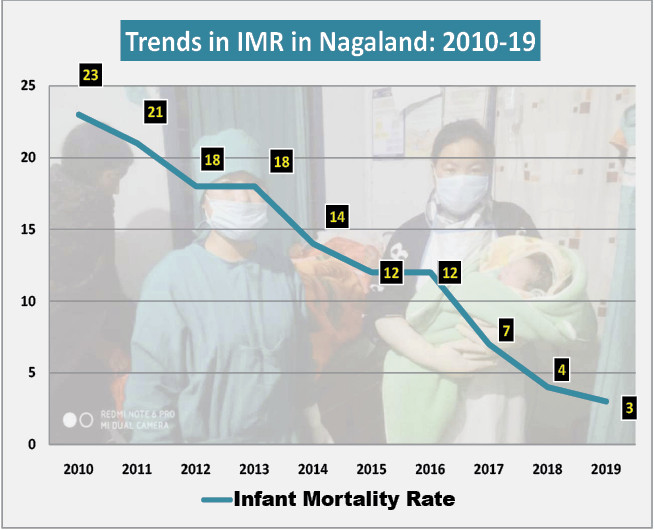Source: Sample Registration System (SRS) Bulletin, Office of the Registrar General, India, Ministry of Home Affairs, Government of India. Trends in Infant Mortality Rate in Nagaland from 2010-2019. Photo in Plot Area: An ANM Chomi, with the mother and newly born baby at a health centre in Nagaland. The IMR in the State has decreased from 23 in 2011 to 3 in 2019.

Moa Jamir
Dimapur | October 29
In what could be considered as a significant achievement in maternal and child care, the State of Nagaland has been able to bring down the Infant Mortality Rate (IMR) considerably in the last 10 years, as per the latest Sample Registration System (SRS) Bulletin.
According to the Bulletin released this week, the IMR in Nagaland has decreased from 4 in 2018 to 3 in 2019, showing the best performance among the States and Union Territories (UTs) in India along with Mizoram.
IMR is defined as the “infant deaths (less than one year) per thousand live births in a given time period and for a given region.”
The decrease is quite significant as one decade before in 2010, the State’s IMR was hovering at 23 per 1000, and the 2019 status reflected an 86.95% decline in a decade.
According to the Bulletin, the IMR is “widely accepted as a crude indicator of the overall health scenario of a country or a region.”
Declining trends
According to the SRS Bulletins published over the years, the IMR in Nagaland has been showing declining trends in the past decade, witnessed most significant improvement after 2016, when the rate decreased from 12 to 7.
However, there has been continuous improvement in the last decade, with IMR declining from 23 in 2010 to 21 in 2011, which further decreased to 18 in 2012.
After remaining static in 2013, the IMR fell to 14 in 2014, and 12, the next year.
Again in 2016, the rate neither increased nor decreased, but 2017 saw the biggest improvement, with the IMR falling from 12 to 7. It further decreased to 4 in 2018 and 3 in 2019. (See chart)
Overall, the national IMR rate stood at 30 in 2019 and the All India IMR level has declined from 47 to 30 in the last decade, the Bulletin informed.
Despite the decline in IMR over the last decades, one in every 33 infants die within first year of their life at the National level (irrespective of rural-urban), it said.
Among the States/Union Territories, the IMR ranged from 3 in Mizoram and Nagaland to 46 in Madhya Pradesh for 2019.
In the North East, Assam had the highest IMR at 40, followed by Meghalaya (33) and Arunachal Pradesh (29). It was 21 in Tripura, 10 in Manipur, 5 in Sikkim, and 3 each in Nagaland and Mizoram.
Meanwhile, the Bulletin informed that the birth rate or “the number of live births per thousand population in a given region and year” for Nagaland in 2019 was 12.7 against the national average of 19.7.
“The number of deaths per thousand population in a given region and time period” or death rate was 3.5 in Nagaland and 6.0 across India.
What is SRS Bulletin?
The SRS, published by Office of the Registrar General, India, under Ministry of Home Affairs, Government of India, is termed to be a “reliable annual estimates of Infant mortality rate, birth rate, death rate and other fertility & mortality indicators at the national and sub-national levels.”
It is based on large-scale demographic survey conducted every year by Office of the Registrar General, India in all States/Union Territories.
Birth Rate is a crucial determinant of population growth while death rate is one of the basic components of population change and the related data is essential for demographic studies and public health administration.
The Bulletin is published periodically by the Office of the Registrar General.






